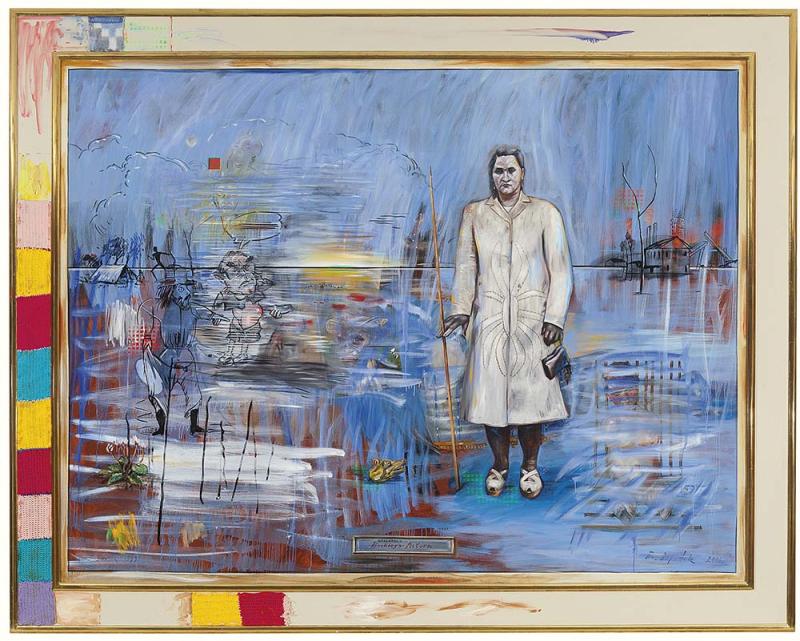JUAN DAVILA born 1946
Portrait of Enriqueta Gallardo (Buckley's Return) 1999
Estimate: $75000 - 95000
Sold For:
$70000 hammer
Description
JUAN DAVILA born 1946
Portrait of Enriqueta Gallardo (Buckley's Return) 1999
oil, gold leaf and mixed media on canvas laid on board
238.0 x 300.5 cm (framed)
signed and dated lower left: J Davila 1999
signed, dated and inscribed verso: "PORTRAIT OF ENRIQUETA GALLARDO"/ JUAN DAViLA 1999/ JUAN DAViLA 1999
Provenance:
Greenaway Art Gallery, Adelaide, 2000
Private collection, Adelaide
Exhibited:
Juan Davila, Greenaway Art Gallery, Adelaide, February - March 2000
Reference:
Walker, W., 'Brushed-up issues', The Advertiser, Adelaide, 21 February 2000, p.28 (illus.)
Estimate: $75000 - 95000
Result Hammer: $70000
Portrait of Enriqueta Gallardo (Buckley’s Return) 1999 is one of a seminal group of six large-scale paintings first exhibited at Greenaway Art Gallery, Adelaide, in 2000. The works, all of which satirized then-Prime Minister John Howard, made some powerful statements surrounding the Howard Government‘s policies. Paying particular attention to his perceived view of the government’s antiquated treatment of aboriginal people, along with its tough stance on immigration - notably the treatment of immigrants at the Woomera detention centers in South Australia – Davila’s paintings of the period demonstrate an enduring poignancy some fifteen years on.
Chilean-born Davila was a key exponent of Australian Postmodernism along with Imants Tillers, Gordon Bennett and Tim Johnson. Perhaps the most significant movement in contemporary art since the eighties, it developed a new visual language with a focus on the Postmodernist concepts of the death of the author and the world as a global village. Appropriating images, styles and motifs from other artists as well as high culture and the every-day, the Postmodernists de-contextualized pre-existing imagery in order to redefine their own perspectives:
'...Davila's primary artistic method was appropriation: he borrowed images from high art, the mass media, science fiction, homosexual pornography and the cultures of Latin America. His painting was virulent because he copied his models with violent intent, corrupting their original meanings. Davila's works were linked to modernism because this idea of copying - as the means of possessing and altering an original so that it could never be seen in the same way again - was common amongst modernist artists such as Picasso in the early 20th century. Both Davila and Tillers were highly conscious of their positions at the margins of world art. Whereas Tillers' politics remained grounded in the discourse of art, Davila's paintings were edged with a hostility and anger produced by the radical politics of his Chilean origins and coloured by his representation of homosexual desire'.1
Portrait of Enriqueta Gallardo (Buckley’s Return) 1999 is a valuable and insightful example of Davila’s Postmodernism, offering a visual amalgamation of multiple and complex historical, political and social references. Here, all fingers point to John Howard with his pants down, the remnants of a scratched out ‘sorry’ hang in the air. A figure behind bars is scribbled out, their identity concealed. The pseudo plaque’s inscription ‘Buckley’s Return’ refers to William Buckley, a convict who lived for thirty-two years amongst the Aborigines in the early nineteenth century. Considered by some as ‘the hero of the wild’, he subsequently worked as a government guide and conciliator between white and indigenous Australians. The portrait of Enriqueta Gallardo, standing tall with handbag and spear, is multitudinous in its origins and meaning. Obvious references include Latin American culture, Russell Drysdale’s Drover’s Wife, Arthur Boyd’s ‘half-caste bride’ and notions of multiculturalism and transgenderism. Davila clearly demonstrates that identity, gender and history are not fixed or constant, rather are in a constant state of change.
Davila is a passionate advocate of the need for art to debate and his paintings often test our tolerance for the absurd and the profane, pushing us to question our moral bearings on civil and political issues. It is perhaps for this reason that Davila's Hysterical Tears series of paintings from the early 1980s; The Fable of Australian Painting, 1983 (Collection of the Museum of Contemporary Art, Sydney) and Stupid as a Painter (Collection of Kerry Stokes, Perth), are just some examples of works that have become icons of Australian art.
Footnotes
1 Green, C., Peripheral Vision - Contemporary Australian Art 1970-1994, Sydney, 1995, p. 73
Tracy Le Cornu BA
Location
SYDNEY VIEWING. 6 - 9 March 11am - 6pm. 12 Todman Avenue, Kensington
MELBOURNE VIEWING. 13 - 19 March 11am - 6pm. Stonington Mansion, 336 Glenferrie Rd, Malvern
